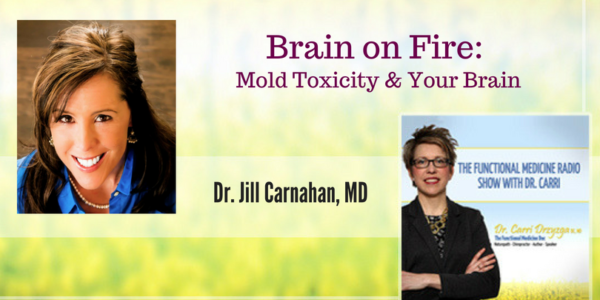Podcast: Play in new window | Download
Subscribe: Apple Podcasts | Android | RSS
In this episode of The Functional Medicine Radio Show, Dr. Carri’s special guest Dr. Jill Carnahan explains ‘brain on fire’ – mold toxicity and its effect on brain health.
Dr. Jill Carnahan completed her residency at the University of Illinois Program in Family Medicine and medical degree from Loyola University School of Medicine in Chicago. She is dually board-certified in Family Medicine (ABFM) and Integrative Holistic Medicine (ABIHM). Dr. Jill is also certified in Functional Medicine through the Institute of Functional Medicine.
Dr. Jill is a 17-year survivor of breast cancer and Crohn’s disease and is passionate about teaching patients how to “live well” and thrive in the midst of a complex and chronic illness. She is also committed to teaching other physicians how to address underlying cause of illness rather than just treating symptoms through the principles of functional medicine.
Main Questions Asked about Brain on Fire & Mold Toxicity:
- What’s the difference between what is normal and what is not normal when it comes to brain health?
- How do we know if we’ve got ‘brain on fire’ or been exposed to mold or a water-damaged building?
- Can you talk about the test for mold?
- Are there any red flags that I might be suffering from mold toxins?
Key Points made by Dr. Jill about Brain on Fire & Mold Toxicity:
- We really should be pretty sharp and on it. Our cognitive abilities shouldn’t dramatically decline over a year’s period of time, for example. One thing that’s important in Alzheimer’s and dementia, and then also in this illness ‘brain on fire’, is genetics.
- One thing that’s a clue to me if someone in their 40s and 50s is having significant sudden decline in cognition, that’s not a normal process. That’s not normal even for Alzheimer’s disease.
- Super common symptoms of ‘brain on fire’ are foggy brain, word finding, difficulty with concentration, memory, calculations. The gut can be affected. Often patients will have heartburn. They’ll have gas or bloating or diarrhea/constipation, abnormal bowel function. The lungs and sinuses, because it’s an airborne toxin in some cases. There’s actually a whole slew of toxins in water-damaged buildings.
- One of things I find that’s a big clue for ‘brain on fire’ is their history. I’ll say, “When did you feel well? When did you last feel well?”
- When we talk about biotoxins, it is just a way to describe bio, meaning living, toxins or things that come from living sources. That would include mold, ticks, or things that carry babesia, bartonella, borrelia, and all of those kinds of infections. Other types of biotoxins that could also cause a similar presentation as mold would be singulatara, some kinds of toxins from blue-green algae, and some of the toxins in the fish like grouper, snapper.
- The number one thing when you’re dealing with this illness is exposure. You really can’t make a huge dent in their treatment or their recovery from ‘brain on fire’ unless you get them in a safe environment. That’s the hard thing. Honestly, that’s 80% of the treatment.
- History is huge. There’s very often I make a pretty presumed diagnosis based on a really good history. I will always back it up with the science, with the lab testing. I never jump to conclusions, but a history alone can give you a pretty good idea if this person is having a mold exposure.
- A great test is the MycoTox test.
- Other tools than lab tests are used such as screening and visual contrast testing.
- There is an organization called the International Society for Environmentally Acquired Illness. I highly recommended it for people who are interested in or treating mold-related illness. This is where the next generation of education and papers and research is going to come from.
- So often, the immune system is overloaded by this exposure, whatever it is. The body just can’t keep up and becomes ill because of it. I think environmental toxic load, in general, is the biggest next epidemic that we need to know about.
- Often, when people are not getting better according to my protocol, which I know should probably work, I’m like, what else?
- If you make major changes in your health, you should see changes within three to six months. If you’re doing the diet, if you’re getting good sleep, if you’re taking your supplements. If you’re doing all of this stuff you’re supposed to be doing, you should see changes within three to six months. If you don’t, there’s something that’s being missed. It could be mold. It could be toxins.
Resources Mentioned for Brain on Fire & Mold Toxicity:
Interview – What You Should Know About Gut Microbiome with Dr. Jill Carnahan
Interview – Alzheimer’s Prevention and Treatment with Dr. Dale Bredesen
The International Society for Environmentally Acquired Illness
Dr. Jill’s Free Mold Guide: I’ve Been Exposed to Mold – Now What?
Book – Reclaim Your Energy and Feel Normal Again
Thank you for listening! If you enjoyed this podcast, please subscribe and leave a 5-star rating and review on iTunes!




